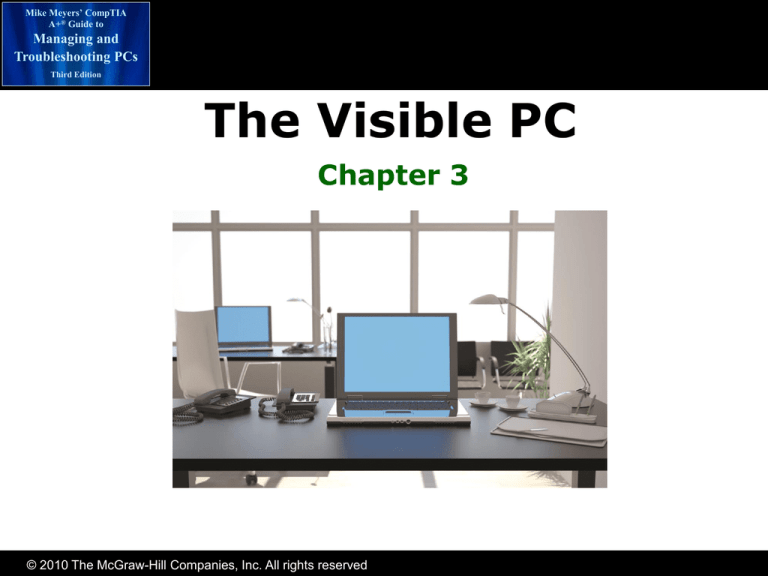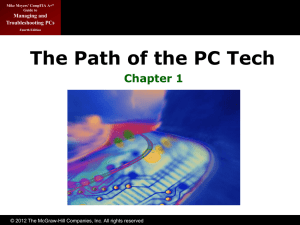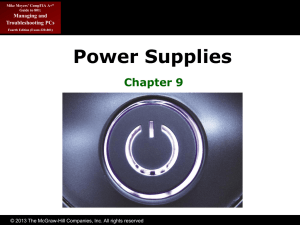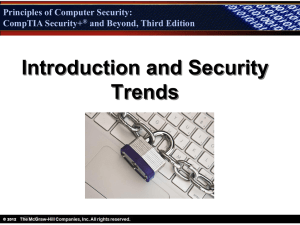
Mike Meyers’ CompTIA
A+® Guide to
Managing and
Troubleshooting PCs
Third Edition
The Visible PC
Chapter 3
© 2010 The McGraw-Hill Companies, Inc. All rights reserved
Mike Meyers’ CompTIA
A+® Guide to
Managing and
Troubleshooting PCs
Overview
Third Edition
• In this chapter, you will learn how to
– Describe how the PC works
– Identify all the connectors and devices on a typical
PC system unit
– Discuss the major internal components of a PC
© 2010 The McGraw-Hill Companies, Inc. All rights reserved
Mike Meyers’ CompTIA
A+® Guide to
Managing and
Troubleshooting PCs
How the PC Works
Third Edition
• Hardware
– Pieces you can kick (mouse, monitor, motherboard,
etc.)
• Software
– Operating system (Windows, Mac OS X, Linux)
– Applications (PowerPoint, Word, Outlook, Internet
Explorer)
© 2010 The McGraw-Hill Companies, Inc. All rights reserved
Mike Meyers’ CompTIA
A+® Guide to
Managing and
Troubleshooting PCs
How the PC Works (continued)
Third Edition
Input
• Getting data into the computer
• Keyboard, mouse, webcam, etc…
Processing
• Occurs when the computer processes or
manipulates data
• CPU
Output
• Provided as the result of processing data
• Softcopy (monitor), Hardcopy (printer)
Storage
• Keep the data for later use
• Hard drive, optical media, flash drive
© 2010 The McGraw-Hill Companies, Inc. All rights reserved
Mike Meyers’ CompTIA
A+® Guide to
The Art of the PC Technician
Managing and
Troubleshooting PCs
Third Edition
• The Art of the PC Technician
– Hardware and software interact to accomplish the
four stages
– Your goal is to understand all the parts and how
they interact in the various stages
• By understanding how it works, you’re better able to fix it
when it breaks
`
Broken PC
`
PC tech
© 2010 The McGraw-Hill Companies, Inc. All rights reserved
Fixed PC
Mike Meyers’ CompTIA
A+® Guide to
Managing and
Troubleshooting PCs
The Complete PC
Third Edition
• Name the big pieces
© 2010 The McGraw-Hill Companies, Inc. All rights reserved
Mike Meyers’ CompTIA
A+® Guide to
Managing and
Troubleshooting PCs
External Connections
Third Edition
• Plug goes into a port
• Port/jack accepts a plug
• Connector can be either a port or a plug
© 2010 The McGraw-Hill Companies, Inc. All rights reserved
Mike Meyers’ CompTIA
A+® Guide to
Managing and
Troubleshooting PCs
External Connections (continued)
Third Edition
• There are six basic types of
connections:
– Mini-DIN connectors
– USB connectors
– FireWire connectors
– DB connectors
– RJ connectors
– Audio connectors
© 2010 The McGraw-Hill Companies, Inc. All rights reserved
Mike Meyers’ CompTIA
A+® Guide to
Managing and
Troubleshooting PCs
Mini-Din Connectors
Third Edition
• DIN connectors are round
and come in two sizes:
– DIN (ancient)
– Mini-DIN (a.k.a. PS/2)
• Always a female connector
• Used by a keyboard or mouse
© 2010 The McGraw-Hill Companies, Inc. All rights reserved
Mike Meyers’ CompTIA
A+® Guide to
Managing and
Troubleshooting PCs
USB Connectors
Third Edition
• Universal Serial Bus
(USB)
USB B
– Used by many devices today
– Devices are hot-swappable
• USB B plugs into devices
• USB A plugs into
computers
• USB mini-B connects to
smaller devices
© 2010 The McGraw-Hill Companies, Inc. All rights reserved
USB A
Mike Meyers’ CompTIA
A+® Guide to
Managing and
Troubleshooting PCs
FireWire Connectors/IEEE 1394
Third Edition
• FireWire connectors move data at
incredibly high speeds
– Also known as IEEE 1394
• Do not confuse this with the IEEE 1284 (parallel
standard)
– Popular with video applications.
– Uses a six-wire connector (note
the rounded edge)
– Some devices use a four-wire
connector
– Hot-swappable
– Faster FireWire devices use
a nine-wire connector
© 2010 The McGraw-Hill Companies, Inc. All rights reserved
Mike Meyers’ CompTIA
A+® Guide to
Managing and
Troubleshooting PCs
DB Connectors
Third Edition
• DB connectors have a slight D shape
• Male DB connectors have pins
• Female DB connectors
have sockets
• DB is the oldest type of
connector in the PC
• Officially called D-shell or
D-subminiature
© 2010 The McGraw-Hill Companies, Inc. All rights reserved
Mike Meyers’ CompTIA
A+® Guide to
Managing and
Troubleshooting PCs
RJ Connectors
Third Edition
• Registered jack or RJ connectors
• RJ-11 connectors are used by telephone
lines
• RJ-45 connectors are used in network
interface cards (NICs)
© 2010 The McGraw-Hill Companies, Inc. All rights reserved
Mike Meyers’ CompTIA
A+® Guide to
Managing and
Troubleshooting PCs
Audio Connectors
Third Edition
• Audio connectors are
found on sound cards
– Used to connect speakers,
microphones, and other
audio devices
• Mini-audio jacks
– Also called 1/8” jack
© 2010 The McGraw-Hill Companies, Inc. All rights reserved
Mike Meyers’ CompTIA
A+® Guide to
Managing and
Troubleshooting PCs
All the Colors of the Rainbow
Third Edition
• The connections on the back of the
computer have been standardized
Connection
Color
VGA
Blue
Parallel
Burgundy
Audio Line-In
Blue
Audio Line-Out
Lime
Microphone
Pink
PS/2 Mouse
Green
PS/2 Keyboard
Purple
© 2010 The McGraw-Hill Companies, Inc. All rights reserved
Mike Meyers’ CompTIA
A+® Guide to
Managing and
Troubleshooting PCs
Third Edition
Devices and Their Connectors
© 2010 The McGraw-Hill Companies, Inc. All rights reserved
Mike Meyers’ CompTIA
A+® Guide to
Managing and
Troubleshooting PCs
Cards vs. On-boards
Third Edition
• Connectors are exposed
on the rear and front of
PCs
• Some connectors attach
directly to the
motherboard
• Some connectors attach
to boards that plug into
the motherboard
© 2010 The McGraw-Hill Companies, Inc. All rights reserved
Mike Meyers’ CompTIA
A+® Guide to
Managing and
Troubleshooting PCs
Keyboard
Third Edition
• Keyboards connect into dedicated miniDIN (usually purple) or USB
• Mini-DIN plugs and ports are usually
either purple (for keyboards) or green
(for mice)
© 2010 The McGraw-Hill Companies, Inc. All rights reserved
Mike Meyers’ CompTIA
A+® Guide to
Managing and
Troubleshooting PCs
Monitors
Third Edition
• Monitors connect to ports on video cards
– S-Video connector (left)
– Digital visual interface (DVI) connector (center)
– 15-pin blue female DB connector (right)
© 2010 The McGraw-Hill Companies, Inc. All rights reserved
Mike Meyers’ CompTIA
A+® Guide to
Managing and
Troubleshooting PCs
Sound
Third Edition
•
•
•
•
•
Converts digital information into sound
Converts sound from a microphone into digital data
Mini-audio jacks for speakers and microphones
DB-15 connector for a joystick or musical instrument
Newer Sony/Phillips digital interface format
(S/PDIF)
© 2010 The McGraw-Hill Companies, Inc. All rights reserved
Mike Meyers’ CompTIA
A+® Guide to
Managing and
Troubleshooting PCs
Video vs. Sound
Third Edition
• Two types of 15-pin connections
– 15-pins in 3 rows VGA (video connections)
– 15-pins in 2 rows MIDI, could connect an old
joystick, or musical instrument
VGA (15 pins/3 row)
MIDI Port
© 2010 The McGraw-Hill Companies, Inc. All rights reserved
Mike Meyers’ CompTIA
A+® Guide to
Managing and
Troubleshooting PCs
Network
Third Edition
• Networks: groups of PCs connected
together
• Network interface cards (NICs) typically
on motherboard (can be expansion card)
• Typical connector is RJ-45
© 2010 The McGraw-Hill Companies, Inc. All rights reserved
Mike Meyers’ CompTIA
A+® Guide to
Managing and
Troubleshooting PCs
Mouse
Third Edition
• A mouse enables you to select
graphical items on a screen
• Connects through mini-DIN
port (light green), USB port, or
Bluetooth
• A trackball may be used
instead of mouse
© 2010 The McGraw-Hill Companies, Inc. All rights reserved
Mike Meyers’ CompTIA
A+® Guide to
Managing and
Troubleshooting PCs
Modem
Third Edition
• Modems convert analog telephone
signals into digital data and vice-versa
– Internal modems are expansion cards
– External modems connect to a serial port or
a USB port
– May use one or two RJ-11 sockets
• Cable from wall to computer is
mandatory, and from computer to phone
is optional
© 2010 The McGraw-Hill Companies, Inc. All rights reserved
Mike Meyers’ CompTIA
A+® Guide to
Managing and
Troubleshooting PCs
Printer
Third Edition
• Printers output data from the PC onto
paper
• Historically used a female DB-25 on the
computer side and a Centronics
connection on the printer side
• Today, printers use USB or wireless
connections
© 2010 The McGraw-Hill Companies, Inc. All rights reserved
Mike Meyers’ CompTIA
A+® Guide to
Managing and
Troubleshooting PCs
Joysticks
Third Edition
• Joysticks are used almost
exclusively to play games on
the computer
– Originally designed as an input
device to be used like a mouse
– DB-15 connector (typically orange)
– Most joysticks use USB today
© 2010 The McGraw-Hill Companies, Inc. All rights reserved
Mike Meyers’ CompTIA
A+® Guide to
Managing and
Troubleshooting PCs
eSATA
Third Edition
• Special connector for external hard
drives and optical drives
© 2010 The McGraw-Hill Companies, Inc. All rights reserved
Mike Meyers’ CompTIA
A+® Guide to
Managing and
Troubleshooting PCs
Third Edition
Inside the System Unit
© 2010 The McGraw-Hill Companies, Inc. All rights reserved
Mike Meyers’ CompTIA
A+® Guide to
Managing and
Troubleshooting PCs
Case
Third Edition
• The case houses all of the internal
components
– Protects internal components
– External connections in front and rear
– Provides access to storage devices such as CDs
© 2010 The McGraw-Hill Companies, Inc. All rights reserved
Mike Meyers’ CompTIA
A+® Guide to
Managing and
Troubleshooting PCs
Going Inside
Third Edition
• Most cases open with a Phillips
screwdriver
• Some use thumbscrews
• Proprietary cases open in odd ways, like
with Torx wrenches
• When inside, be careful!
– ESD issues
– Dropped screws (use plastic tools)
• Inside you’ll find internal components:
– Motherboard
– Devices attached to the motherboard
– Start in the center with the CPU
© 2010 The McGraw-Hill Companies, Inc. All rights reserved
Mike Meyers’ CompTIA
A+® Guide to
Managing and
Troubleshooting PCs
CPU
Third Edition
• Central processing
unit (CPU)
– Also called a
microprocessor
• Performs calculations
• Generates a lot of heat
– Cooling fan and/or heat
sink used to keep them
cool
© 2010 The McGraw-Hill Companies, Inc. All rights reserved
Mike Meyers’ CompTIA
A+® Guide to
Managing and
Troubleshooting PCs
CPU (continued)
Third Edition
• Makes
– Intel
– AMD
• CPUs come in different
packages:
• Models
–
–
–
–
Phenom
Athlon
Pentium
Core
© 2010 The McGraw-Hill Companies, Inc. All rights reserved
– Pin grid array (PGA)
– Land grid array (LGA)
Mike Meyers’ CompTIA
A+® Guide to
Managing and
Troubleshooting PCs
RAM
Third Edition
• Random access memory (RAM)
– Stores programs and data currently used by
the CPU
– Measured in megabytes (MB) and gigabytes (GB)
– Each piece or module of RAM called a stick
– Dual inline memory module (DIMM) most common
today
© 2010 The McGraw-Hill Companies, Inc. All rights reserved
Mike Meyers’ CompTIA
A+® Guide to
Managing and
Troubleshooting PCs
Motherboards
Third Edition
• The motherboard is a thin,
flat piece of circuit board
– Everything connects directly or
indirectly to the motherboard
– Contains sockets for the CPU,
RAM, power, and external
devices such as mice, printers,
and keyboards
– Expansion slots allow the
addition of new components
© 2010 The McGraw-Hill Companies, Inc. All rights reserved
Mike Meyers’ CompTIA
A+® Guide to
Managing and
Troubleshooting PCs
Power Supply
Third Edition
• Provides electrical power
to PC components
– Uses 110-VAC power from the
wall outlet
– Has power connectors for the
motherboard and other
devices
– Uses a fan to keep itself and
the PC cool inside
• Safety Alert!
– High-voltage capacitor holds
power after being unplugged
© 2010 The McGraw-Hill Companies, Inc. All rights reserved
Mike Meyers’ CompTIA
A+® Guide to
Managing and
Troubleshooting PCs
Floppy Drive
Third Edition
• The floppy drive uses floppy diskettes to
store data
– Connects to the computer via a ribbon cable
– Connects to the floppy controller on the
motherboard
– Uses a connector from the power supply
© 2010 The McGraw-Hill Companies, Inc. All rights reserved
Mike Meyers’ CompTIA
A+® Guide to
Managing and
Troubleshooting PCs
Hard Drive
Third Edition
• Hard drives store programs and data not
currently in use by the CPU
– Capacity is quoted in megabytes (MB) or
gigabytes (GB).
– A typical PC has one hard drive but may contain
more
– Common types include:
• Parallel AT attachment (PATA)
• Serial AT attachment (SATA)
• Small computer system
interface (SCSI)
• Uses a power cable from the
power supply
© 2010 The McGraw-Hill Companies, Inc. All rights reserved
Mike Meyers’ CompTIA
A+® Guide to
Managing and
Troubleshooting PCs
Optical Media Drives
Third Edition
• Three groups
– CD
• Stores about 700 MB of data
– DVD
• Stores about 4-16 GB of data
– Blu-ray Disc (BD)
• Stores about 25-50 GB of
data
© 2010 The McGraw-Hill Companies, Inc. All rights reserved
Mike Meyers’ CompTIA
A+® Guide to
Managing and
Troubleshooting PCs
Third Edition
© 2010 The McGraw-Hill Companies, Inc. All rights reserved









